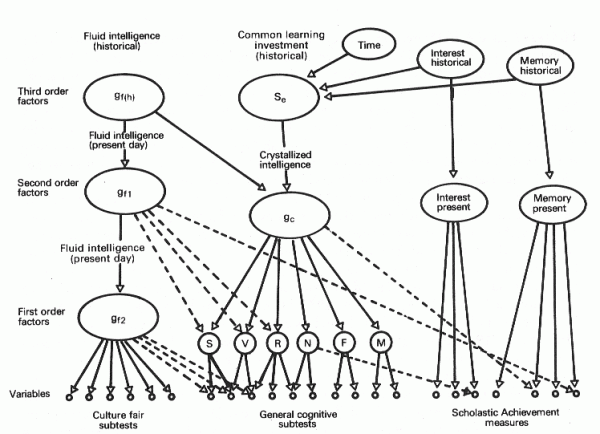Cattell's Intelligence Model and What It Can Teach Us

The construct of intelligence has been widely studied as part of the psychology of individual differences. But the ambiguity of the term intelligence has caused some problems. Hence the multitude of models that try to explain intellect, each from very different perspectives. They range from theories based on a single factor to theories of multiple intelligences. However, in this article we will talk about Cattell’s Intelligence Model, which takes a mixed perspective.
Raymond B. Cattell is one of the most well-known authors in the psychology of individual differences. Cattell has studied intelligence in depth. He developed a model based on two central factors: fluid intelligence (Gf) and crystallized intelligence (Gc). Cattell’s model differs from Spearman’s conception of intelligence as a single unit.
To understand the theory developed by Cattell in depth, it is essential to understand what its two main factors are. Therefore in the next section we will explain what fluid intelligence and crystallized intelligence are.
Factors in Cattell’s intelligence model
Fluid Intelligence (Gf)
First of all, Gf refers to the ability to adapt and face new situations in a flexible way, without prior learning being a determining factor. Fluid intelligence is basically shaped by primary aptitudes, including induction and deduction, relationships and classifications, and the breadth of working memory, or intellectual speed.

This type of intelligence is closely linked to genetic factors and an individual’s development. We can see that fluid intelligence reaches its maximum power in adolescence. Then, it tends to decrease as we age and our nervous system breaks down.
Gf can be evaluated with tests that measure the biological potential that each individual has to learn or acquire knowledge. In fact, fluid intelligence is often called the hardware of intelligence because it underpins an individual’s future abilities.
Crystallized Intelligence (Gc)
Secondly, this factor of Cattell’s Intelligence Model refers to the set of skills, strategies and knowledge that represent the level of cognitive development a person achieves throughout their learning history. Examples of crystallized intelligence are verbal comprehension, evaluation of experience, spatial orientation, and mechanical knowledge.
Unlike fluid intelligence, crystallized intelligence has little to do with a person’s genes. It instead depends to a great extent on learning derived from a person’s past experiences in their cultural environment. A person will develop their crystallized intelligence insofar as they invest their fluid intelligence in learning-based activities.
Tests for Gc evaluate the knowledge a person acquires through interaction with their sociocultural environment. If we can say that fluid intelligence represents hardware, then crystallized intelligence would be the software.

Structure of Cattell’s intelligence model
Cattell’s intelligence model structures intelligence into three hierarchical levels. The levels are the following:
First-order factors: the most specific factors within the model. They consist of primary mental aptitudes such as memory, cognition, and evaluation, similar to the skills in the Thurstone model.
Second order factors: much more general than the first order. Here, present fluid intelligence and crystallized intelligence stand out, which will determine the factors below them are expressed.
Third order factors: the most generic aspects of the model. It is historical fluid intelligence and is based on common learning investment (see below) from environments like school and family.

The construct of intelligence has been widely studied as part of the psychology of individual differences. But the ambiguity of the term intelligence has caused some problems. Hence the multitude of models that try to explain intellect, each from very different perspectives. They range from theories based on a single factor to theories of multiple intelligences. However, in this article we will talk about Cattell’s Intelligence Model, which takes a mixed perspective.
Raymond B. Cattell is one of the most well-known authors in the psychology of individual differences. Cattell has studied intelligence in depth. He developed a model based on two central factors: fluid intelligence (Gf) and crystallized intelligence (Gc). Cattell’s model differs from Spearman’s conception of intelligence as a single unit.
To understand the theory developed by Cattell in depth, it is essential to understand what its two main factors are. Therefore in the next section we will explain what fluid intelligence and crystallized intelligence are.
Factors in Cattell’s intelligence model
Fluid Intelligence (Gf)
First of all, Gf refers to the ability to adapt and face new situations in a flexible way, without prior learning being a determining factor. Fluid intelligence is basically shaped by primary aptitudes, including induction and deduction, relationships and classifications, and the breadth of working memory, or intellectual speed.

This type of intelligence is closely linked to genetic factors and an individual’s development. We can see that fluid intelligence reaches its maximum power in adolescence. Then, it tends to decrease as we age and our nervous system breaks down.
Gf can be evaluated with tests that measure the biological potential that each individual has to learn or acquire knowledge. In fact, fluid intelligence is often called the hardware of intelligence because it underpins an individual’s future abilities.
Crystallized Intelligence (Gc)
Secondly, this factor of Cattell’s Intelligence Model refers to the set of skills, strategies and knowledge that represent the level of cognitive development a person achieves throughout their learning history. Examples of crystallized intelligence are verbal comprehension, evaluation of experience, spatial orientation, and mechanical knowledge.
Unlike fluid intelligence, crystallized intelligence has little to do with a person’s genes. It instead depends to a great extent on learning derived from a person’s past experiences in their cultural environment. A person will develop their crystallized intelligence insofar as they invest their fluid intelligence in learning-based activities.
Tests for Gc evaluate the knowledge a person acquires through interaction with their sociocultural environment. If we can say that fluid intelligence represents hardware, then crystallized intelligence would be the software.

Structure of Cattell’s intelligence model
Cattell’s intelligence model structures intelligence into three hierarchical levels. The levels are the following:
First-order factors: the most specific factors within the model. They consist of primary mental aptitudes such as memory, cognition, and evaluation, similar to the skills in the Thurstone model.
Second order factors: much more general than the first order. Here, present fluid intelligence and crystallized intelligence stand out, which will determine the factors below them are expressed.
Third order factors: the most generic aspects of the model. It is historical fluid intelligence and is based on common learning investment (see below) from environments like school and family.

This text is provided for informational purposes only and does not replace consultation with a professional. If in doubt, consult your specialist.







